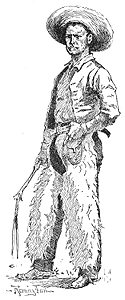
| Photos From Wyoming Tales and Trails This Page: Theodore Roosevelt, Pelican Creek, Fort Yellowstone, Hirem M. Chittenden |
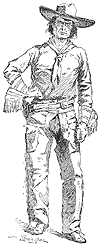 |

| Photos From Wyoming Tales and Trails This Page: Theodore Roosevelt, Pelican Creek, Fort Yellowstone, Hirem M. Chittenden |
 |
[ Cambria ] [ Big Horn Basin ] [ Thermopolis ] [ Buffalo ] [ Photos V ] [ Laramie ] [ Laramie II ] [ Medicine Bow ] [ Cheyenne ] [ Sheepherding ] [ Superior ] [ Sheridan ] [ Kemmerer ] [ USS Wyoming ] [ Ghost Towns ] [ Ghost Towns II ] [ Rock Springs ] [ Centennial ] [ Deadwood Stage ] [ Lusk ] [ Douglas ] [ Encampment ] [ Rudafeha Mine ] [ Rawlins ] [ Casper-N. Platte Valley ] |
| Big Piney, 1885-1920* | Evanston* |
Roosevelt took an early interest in the west and owned a ranch in Dakota Territory. In 1885 he published his Hunting Trips of a Ranchman which was reviewed by George Bird Grinnell in his Forest and Stream. In the review Grinnell commented about Roosevelt's "limited experience." The review got Roosevelt's immediate attention with Roosevelt demanding an audience with the intrepid Grinnell. Whatever happened at the interview, it led to a friendship between the two. Roosevelt was also, as a result of his connections to the west and Wyoming, a friend of Owen Wister and Frederic Remington whose sketches of cowboys from Roosevelt's book are used on the top of this page. Roosevelt, in fact, employed Remmington on the ranch in Dakota.
Prior to his trip to Wyoming, Roosevelt had expressed concern Roosevelt, howver, may have discovered a new species. Dr. Merriam did not have available to him DNA testing which is now used to ascertain differences between subspecies. In January 1998, John Etchepare, president of the Warren Livestock Company, commented to the Cheyenne Rotary Club as to the possible presence in the state of Preble's meadow jumping mouse,
"I have never seen one in the 35 years I've spent on the lands owned by Warren Livestock, nor is it ever mentioned in ranch history. However, I just received reports on DNA testing done on a mouse now dead for seven years, and officials believe they have one suspect jumping mouse in Wyoming." It has been recognized that even experts have difficulty in telling the difference between the the western jumping mouse (Zapus princeps), the meadow jumping mouse (Zapus hudsonius), and one subspecies, the Preble's meadow jumping mouse (Zapus hudsonius preblei), using morphological characters. There is, however, a possible morphological difference, the Preble's meadow jumping mouse, on an average, has a slightly smaller cranial size and its molars are, on average, smaller. Thus it has been proposed that the presence of the Preble's mouse be determined using mitochondrial and nuclear markers amplified by polymerase chain reaction using DNA from tissue samples. Several months after Etchepare spoke, portions of Crow Creek, Chugwater Creek, Horse Creek, and Bed Tick Creek in Albany, Converse, Goshen, Laramie and Platte Counties, on May 13, 1998, were declared to be possible habitat for the mouse and entitled to special protection. No definitive study was done as to the presence of the Preble's mouse in these counties. The western and regular jumping mice are not endangered. E. A. Preble is also noted as the discoverer of the dwarf shrew (Sorex namus) near Estes Park. There is also a Merriam's shrew (Sorex Merriami, Dobson, 1890).[Webmaster's note: No relation.] Two months before his death, President Harding also visited the park . See photo above left. Newspaper clippings from the time indicated that the visit resulted in an increase of tourism to the Park. 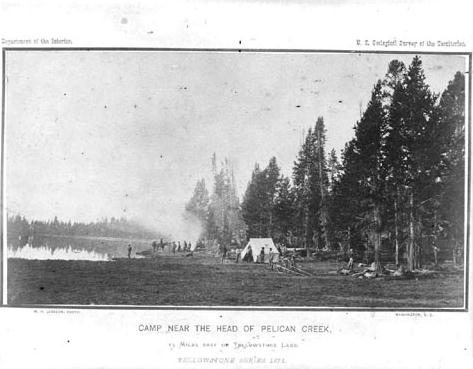 Pelican Creek, Wm. H. Jackson, 1871 Pelican Creek, which flows out of the north end of Lake Yellowstone, was named in 1864 by a group of prospectors led by Adam "Horn" Miller. Supposedly, John C. Davis, seeking his evening repast mistakingly shot a pelican thinking it to be a goose. The "goose" came down in the water requiring Davis to swim out to get it and bring it to shore. Even after defeathering and skinning, however, the pelican proved to be unedible and was hung in a tree to be found by Miller. Miller was one of the developers of Cooke City, Mt., named after Jay Cooke, president of the Northern Pacific Railroad, in the futile hope that Cooke would run a spur line to the city. It was in the Pelican Valley in October of 1883 that soldiers caught Edgar Howell of Cooke City slaughtering five bison. Emerson Hough (1857-1923) was then writing for George Bird Grinnell's Forest and Stream for $15.00 a month. In the March 13, 1884, edition of the magazine he pointed out the absurdity of the penalties for poaching in Yellowstone. All that could be done was expel Howell from the Park only to have him return again. Hough reported that there were only about 100 bison left in the park. Public outrage resulted in the passage of the Lacey Act providing for real penalties for harming animals within the park. Hough later went on to write the Curly cowboy series in the Saturday Evening Post, Passing of the Frontier and The Covered Wagon, devoted to the Texas cattle trails and the Oregon Trail. As was Grinnell, Hough was a personal friend of Theodore Roosevelt.
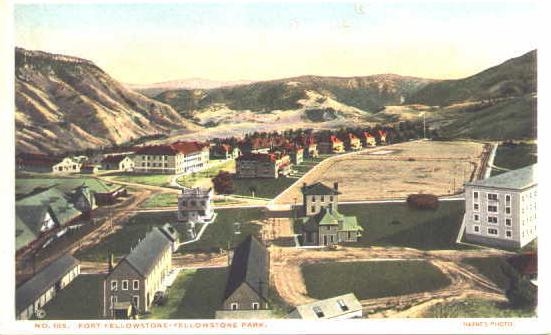 When Yellowstone was established as the nation's first national park in 1872, it was under the administration of the civilians who proved unable to perform the job. Congress, in disgust, in 1886 refused to appropriate any more funds for the administration of the park. The Department of the Interior then called upon the military. Company M, First Cavalry from Ft. Custer was assigned to the post. In 1890 Congress appropriated $50,000 for the construction of buildings. The last building to be built by the military was the chapel, in 1913, after this picture was taken. President Theodore Roosevelt recommended civilian control over Yellowstone and in 1912 his successor President Taft recommended that Congress appropriate funds to turn the park over to civilian control. The Act creating the National Park Service was adopted in 1916 during the Wilson Administration and in October of that year, the National Park service assumed administration. In 1916, the Secretary of the Interior in his report noted that all of the National Parks were open to motor travel and observed that with the construction of roads the parks would become more available to the people. Indeed, by the 30's, automobile travel to Yellowstone became an important contribution to the economy of the state with "autocamps" being located in most cities. For a photo album of an auto tour from Lincoln, through Casper, Thermopolis, Cody and Yellowstone in 1937, visit Joycolyn Knapp's Photo Album. Mrs. Knapp maintained meticulous records of her expenses. In Yellowstone she observed that on August 31 it was necessary to drain the car's radiator due to the 18 degree weather.
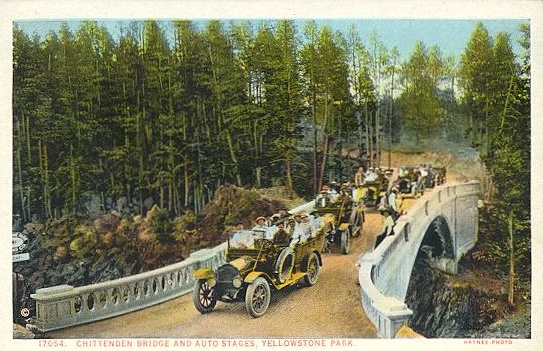 Chittenden Bridge, approx. 1918, Below Left, Sylvan Lake, Photos by Haynes
The original Chittenden Bridge was designed by Park
Engineer Hirem M. Chittenden and was constructed in 1902. At the time it was
the longest bridge of its type in the world. In 1914 its name was changed to
"Fishing Bridge." Chittenden subsequently was promoted to position of District
Engineer for the Seattle District In 1916, "auto stages" manufactured by White Motor Company of Cleveland, Ohio, were introduced into the park replacing stages previously used, see photo below. White motor buses remained in use in the Park until the early 60's, but continued to be used in Glacier National Park until 1999, when metal fatigue problems arose. The metal fatique was as result of modifications made to the chassis when modernizing the running gear. Without the modifications it was determined that the vehicles, many of which were 65 years old, could have continued another 65 years. 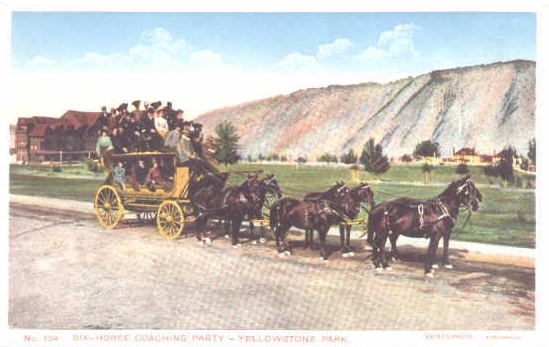 Yellowstone Stage, prior to 1916, photo by Haynes
Gibbon Canyon as well as the Gibbon Geyser Basin and Gibbon River are each named after John Gibbon. Gibbon entered West Point at age 15 and served with distinction in the Union Army during the Civil War. He authorized a military escort for the Washburn expedition into Yellowstone, but is most noted for two military encounters: (1.) At the Little Big Horn Custer disregarded orders that he was not to attack Indians until after Gibbon was in position. Gibbon arrived following the results of Custer's failure to obey orders, relieved Majors Frederick Benteen and Marcus Reno and discovered the remains of Custer's command; (2.) He pursued Chief Joseph, cutting off the Nez Perce at the Battle of Big Hole 45 miles from the border with British North America where Chief Joseph hoped to join Sitting Bull and obtain the protection of the Great Mother, Victoria. Gibbon was wounded in the battle. Subsequently, Chief Joseph and Gibbon became friends. In 1895, Gibbon was elected commander-in-chief of The Loyal Legion of the United States, a Civil War Veteran's organization comprised of Union officers. During the Nez Perce trek Chief Joseph passed through Yellowstone, entering the Park on August 21, 1877. The Nez Perce had encounters with 22 tourists. In the Park two campers were killed. The others were released unharmed. |

